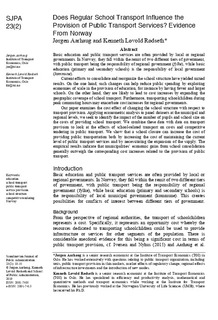| dc.contributor.author | Aarhaug, Jørgen | |
| dc.contributor.author | Rødseth, Kenneth Løvold | |
| dc.coverage.spatial | Norway | nb_NO |
| dc.date.accessioned | 2019-07-05T07:37:22Z | |
| dc.date.available | 2019-07-05T07:37:22Z | |
| dc.date.created | 2019-07-03T10:41:06Z | |
| dc.date.issued | 2019-06-13 | |
| dc.identifier.citation | Scandinavian journal of public administration. 2019, 23 (2), 33-55. | nb_NO |
| dc.identifier.issn | 2001-7405 | |
| dc.identifier.uri | http://hdl.handle.net/11250/2603502 | |
| dc.description.abstract | Basic education and public transport services are often provided by local or regional governments. In Norway, they fall within the remit of two different tiers of government, with public transport being the responsibility of regional government (fylke), while basic education (primary and secondary schools) is the responsibility of local government (kommune). Current efforts to consolidate and reorganize the school structure have yielded mixed results. On the one hand, such changes can help reduce public spending by exploiting economies of scale in the provision of education, for instance by having fewer and larger schools. On the other hand, they are likely to lead to cost increases by expanding the geographic coverage of school transport. Furthermore, transporting schoolchildren during peak commuting hours may exacerbate cost increases for regional governments. Our paper examines the cost effect of changing the school structure with respect to transport provision. Applying econometric analysis to panel datasets at the municipal and regional levels, we seek to identify the impact of the number of pupils and school size on the costs of providing school transport. We combine these data with data on transport provision to look at the effects of school-related transport on costs and competitive tendering in public transport. We show that a school closure can increase the cost of providing public transportation both by increasing the cost of maintaining the current level of public transport services and by necessitating the expansion of the supply. The empirical results indicate that municipalities’ economic gains from school consolidation generally outweigh the corresponding cost increases related to the provision of public transport. | nb_NO |
| dc.description.abstract | Does Regular School Transport Influence the Provision of Public Transport Services? Evidence From Norway | nb_NO |
| dc.language.iso | eng | nb_NO |
| dc.publisher | Scandinavian Journal of Public Administration, School of Public Administration | nb_NO |
| dc.relation.uri | http://ojs.ub.gu.se/ojs/index.php/sjpa/article/view/4203 | |
| dc.rights | Attribution-NonCommercial-NoDerivatives 4.0 Internasjonal | * |
| dc.rights.uri | http://creativecommons.org/licenses/by-nc-nd/4.0/deed.no | * |
| dc.title | Does Regular School Transport Influence the Provision of Public Transport Services? Evidence From Norway | nb_NO |
| dc.type | Journal article | nb_NO |
| dc.type | Peer reviewed | nb_NO |
| dc.rights.holder | © Jørgen Aarhaug, Kenneth Løvold Rødseth and School of Public Administration, 2019 | nb_NO |
| dc.description.version | publishedVersion | nb_NO |
| cristin.unitcode | 7482,1,3,0 | |
| cristin.unitcode | 7482,3,1,0 | |
| cristin.unitname | Regional utvikling og reiseliv | |
| cristin.unitname | Samfunnsøkonomiske analyser | |
| cristin.ispublished | true | |
| cristin.fulltext | original | |
| cristin.qualitycode | 1 | |
| dc.identifier.cristin | 1709677 | |
| dc.source.journal | Scandinavian journal of public administration | nb_NO |
| dc.source.volume | 23 | nb_NO |
| dc.source.issue | 2 | nb_NO |
| dc.source.pagenumber | 33-55 | nb_NO |

